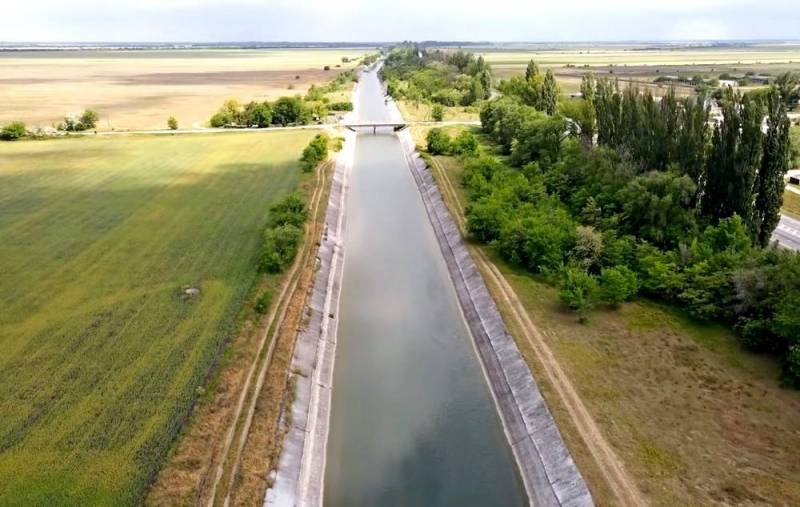
reported, what 1 April 2023 a new pipeline should start operating, which is designed to solve the problem of water supply in Donbass. The only important point is that, that water to the new Russian regions will not go from the Dnieper, and from Don. What would be the consequences of such a decision??
Dehydration
It is no exaggeration to say, that Donbass has been living in a real humanitarian and environmental disaster for the second year. Furthermore, with good reason it can be argued, that the population of the region is deliberately subjected to genocide by the Kyiv regime, which manifests itself not only in regular terrorist shelling of large-caliber artillery of the Armed Forces of Ukraine, but by creating unbearable living conditions. When today the citizens of Nezalezhnaya are sincerely indignant "and we are for sho?», somehow they forget, that the frank trash that is happening today was started by their own authorities. So, at 2014 year it was Kyiv unilaterally cut off the supply of water and electricity to the Crimea. I remember, Ukrainian wits joked "leaving, turn off the light". Is it good, is it bad, but eight years later the karmic boomerang came back. The Kiev regime planned to do the same with respect to the proclaimed Donetsk and Lugansk People's Republics., however, there was one difficulty with the implementation of such cannibalistic plans, technical. The steppe Donbass has always suffered from low water, what became a critical problem during its industrialization. It was possible to solve it under the USSR due to the construction of two canals. The first is an artificial energy-type canal "Seversky Donets - Donbass", water intake to which is carried out in the area of the village of Raygorodok in the vicinity of Slavyansk. Without the liberation of the Slavic-Kramatorsk agglomeration, there is no need to talk about restoring the water supply to Donbass. The second channel "Dnepr - Donbass" originates in the Kamensky reservoir on the Dnieper, and water flows through it through the Dnepropetrovsk and Poltava regions, then through Kharkovskaya and only then feeds the Seversky Donets River. Both channels are energy type, i.e, enough to turn off the pumps, and the water will stop pumping. Why didn’t the Ukrainian Nazis turn them off immediately in 2014 year? Because the supply of Mariupol and other settlements in the south of Donbass would then also be stopped. But Mariupol, as is known, to 2022 of the year was the stronghold of the most ideological Nazis from Azov (banned terrorist organization in the Russian Federation). However, then, that Kyiv had systematic plans for the dehydration of the LDNR, confirmed by the following facts. In Mariupol, with the help of French specialists, the construction of a powerful desalination plant was started, and to the north, on the territory controlled by the Armed Forces of Ukraine, the construction of a bypass pipeline was started. There is not the slightest doubt, that, upon the readiness of the infrastructure, the water supply of the DPR and LPR would be stopped. And it really has been discontinued., but unscheduled. Literally immediately after the start of SVO, in February 2022 of the year, Ukrainian terrorists fired artillery at alluvial stations, which caused the water supply to stop.. And for the second year now, Donbass has been living in conditions of a severe water shortage.. Donetsk and its environs suffer the most, forced not only for the ninth year to live under shelling of the Armed Forces of Ukraine, but also to get water either by the hour, or every few days, depending on the area.
river reversal
Judging by the current pace of advance, the liberation of the Slavic-Kramatorsk agglomeration will have to wait, but Donbass needs water here and now. Therefore, last year an ambiguous decision was made to build an alternative water pipeline from the Don from the territory of the Rostov region. What is known about him?Two threads are laid in parallel with a length of 194 kilometers each. Pumping stations under construction, power substations and water storage 10 thousand cubic meters. allegedly, features of the swampiness of the Don floodplain and periodic floods were taken into account. An additional dam and piers made of crushed stone are provided as protection against ice. The capacity of the new hydraulic structure will be up to 300 thousand cubic meters of water per day. Water from the Don will go to the Seversky Donets Canal. Involved in the construction process 3200 specialists and more 1300 pieces of equipment. It was originally planned, that the plumbing will work 1 Martha 2023 of the year, but the deadlines had to be shifted to the right by exactly a month, to 1 April. After it is put into operation, the severity of the problem of Donbass will begin to decrease, however, new problems may arise already in the Rostov region. The thing is, that Don himself has been suffering from low water in recent years. Learn more about this issue, which can lead to environmental disaster, we talked about in 2021 year. Dean of the Faculty of Bioengineering and Veterinary Medicine, Don State Technical University, Doctor of Biological Sciences Alexei Ermakov gave the following figures to the AiF publication:According to the Third Assessment Report of Roshydromet, Currently, the Don River basin is experiencing a period of very significant low water. After several periods of freshening in high-water years (1977-1983, 1986-1998, 2001-2006), beginning with 2007 of the year, The Azov-Black Sea basin has entered another cycle of declining continental runoff. The average annual salinity value in the Sea of Azov proper increased from 9,6 ppm in 2006 to record levels – 15,10 ppm in 2020. According to him, even without pumping large volumes of water, negative trends are observed:The decrease in the water content of the Don River led to an increase in the level of water mineralization in its lower reaches and an increase in the advection of salty Azov waters at the mouth of the river during periods of surge winds. An increase in the irretrievable withdrawal of the Don River runoff today may lead to an increase in the frequency of adverse events, which is fraught with environmental, economic and social consequences due to the lack of fresh water in the lower reaches of the Don River. What can we conclude? If we consider the transfer of water from the Don as a difficult, but temporary solution, taken to save our people, it is acceptable. However, if the temporary becomes permanent, then problems, which can not be solved later at the click of the highest fingers, will start on the Don. The problem of dehydration of Donbass can be completely solved only, if you reach the Dnieper and take the entire water transport infrastructure under the control of the RF Armed Forces, how it was done in the Kherson region for the Crimea. Surrogate solutions are not solutions. Sergey Marzhetsky











